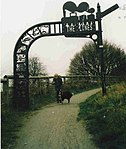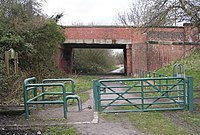Castleford–Garforth line
| Castleford–Garforth line | |
|---|---|
 Castleford Viaduct across the River Aire | |
| Overview | |
| Status | Closed |
| Locale | West Yorkshire, England |
| Termini | |
| Stations | 5 |
| Service | |
| Type | Heavy rail |
| Operator(s) | North Eastern Railway London North Eastern Railway British Rail |
| History | |
| Opened | 8 April 1878 |
| Closed | 1998 (complete closure) |
| Technical | |
| Line length | 6.3 mi (10.1 km) |
| Number of tracks | 1 |
| Track gauge | 1,435 mm (4 ft 8+1⁄2 in) standard gauge |
Castleford–Garforth line | ||||||||||||||||||||||||||||||||||||||||||||||||||||||||||||||||||||||||||||||||||||||||||||||||||||||||||||||||||||||||||||||||||||||||||||||||||||||||||||||||
|---|---|---|---|---|---|---|---|---|---|---|---|---|---|---|---|---|---|---|---|---|---|---|---|---|---|---|---|---|---|---|---|---|---|---|---|---|---|---|---|---|---|---|---|---|---|---|---|---|---|---|---|---|---|---|---|---|---|---|---|---|---|---|---|---|---|---|---|---|---|---|---|---|---|---|---|---|---|---|---|---|---|---|---|---|---|---|---|---|---|---|---|---|---|---|---|---|---|---|---|---|---|---|---|---|---|---|---|---|---|---|---|---|---|---|---|---|---|---|---|---|---|---|---|---|---|---|---|---|---|---|---|---|---|---|---|---|---|---|---|---|---|---|---|---|---|---|---|---|---|---|---|---|---|---|---|---|---|---|---|---|
| ||||||||||||||||||||||||||||||||||||||||||||||||||||||||||||||||||||||||||||||||||||||||||||||||||||||||||||||||||||||||||||||||||||||||||||||||||||||||||||||||
The Castleford–Garforth line was a single-track railway line in West Yorkshire, England, connecting Castleford with Garforth east of Leeds. The route was developed to allow coal to be transported from the area, though a passenger service was operated between 1878 and 1951. Initially promoted by Leeds, Castleford and Pontefract Junction Railway, it was taken over by the North Eastern Railway before the line was completed.
Route
[edit]
Extant line Closed line
The line left the route of the York and North Midland Railway at Castleford East Junction, turning north and crossing Wheldon Road on a plate girder bridge. Curving north-west, it crossed the River Aire east of its junction with the Aire and Calder Navigation on Castleford Viaduct, a long iron bridge. After a level crossing with Ings Lane and passing under Barnsdale Road, it reached Ledston, east of the A656 near Allerton Bywater, with a connection to Allerton Bywater colliery. The line continued along the northern edge of Allerton Bywater. Bowers was situated about one mile northwest of Ledston station, Kippax another three quarters of a mile further, near today's Berry Lane east of Great Preston. From there, the line continued north for about 2 miles (3 km), passed under the A63 road, and curved in a wide S-bend towards the tracks of the Leeds and Selby Railway, crossing Ninelands Lane and joining the main line in a trailing junction immediately east of Garforth station.[1][2]
From a junction north of Bowers, a branch of the line led west towards an opencast mine which is now the place of St Aidan's country park. It served several collieries in the area between Swillington, Astley, and Allerton Bywater.[3]
The length of the line between Castleford East Junction and Garforth was 6.3 miles (10.1 km). Trains between Castleford station and Garforth covered a distance of approximately 7 miles (11 km).[4]
History
[edit]An act for the construction of the line was passed in 1873. Originally built by the Leeds, Castleford and Pontefract Junction Railway (LC&PJR), prior to its opening in 1878 the NER had acquired over three quarters of the shares in the line.[5]
Passenger trains between Castleford and Garforth continued from and to Leeds, serving also the intermediate stations between Garforth and Leeds.[4] Whilst the NER supplied six to seven trains per day at the start, the LNER reduced the service to five trains per day which after nationalisation had become as little as three per day.[6] All local passenger trains were stopped in January 1951, but excursions and diverted passenger trains continued until 1969.[7]
Whilst the line served a sparse population, its original intended purpose of moving coal kept it in traffic until the 1990s. Coal was forwarded out from Allerton Bywater, Allerton Main, Kippax, Lowther and Primrose Hill Collieries. Since 1958, Bowers Disposal Point was the forwarding location for coal mined from the St Aidan's opencast venture.[8] One other coal mine, Trench Colliery, was located near to Garforth and its siding faced north, so that it only traversed a small section of the line. Trench Colliery closed down in 1930[9] and all freight traffic between Garforth and Ledston ended on 14 July 1969.[10]
In the 1980s, spoil from Wheldale Colliery was taken to the tips at Allerton Bywater. This service used National Coal Board (NCB) locomotives with NCB drivers who were qualified to drive on the BR owned branch. These trains ceased in 1987 with the closure of Wheldale.[11] About 1+1⁄2 miles (2.4 km) of track were retained from Castleford East Junction to Ledston to serve Allerton Bywater Colliery and Bowers Row Disposal Point, and later RJB Mining's Ledston Unloading Hopper Compound. These services ended on 6 June 1998.[2]
In 2009 there were reports that Network Rail considered reopening the line to run more services between Castleford and Leeds, but the costs were considered prohibitive given the low population numbers.[12]
Structures
[edit]The major structure of the line is the 840-foot-long (260 m) Castleford Viaduct over the River Aire. It has a bow string centre section with two long plate girder approach spans, supported by sets of tubular steel piers (nine on the southern side, ten on the northern). Due to corrosion, it is in poor condition.[10] A plate girder bridge led the line across Wheldon Road in Castleford. This was demolished in the 2000s to remove a highway height restriction, while the bridges over Brecks Lane (west of Kippax) and over Ninelands Lane were removed after closure (exact dates unknown).[2]
Status of the line
[edit]The tracks north of Ledston have been lifted, and the line has been partly overbuilt in Garforth. About 4 miles (6.4 km) of the line between Silkstone Square in Allerton Bywater and Ninelands Lane on Garforth are now used as a bridleway, known as the Lines Way, as is a 3⁄4-mile (1.2 km) long section of the colliery branch west of Bowers.[2] The intermediate stations have been demolished.
Gallery
[edit]-
Footpath following the former railway line in Allerton Bywater
-
Footpath on the former railway line in Great Preston
-
Bridge of Station Lane, Great Preston, across the former railway line
-
Abandoned track remaining at the southern end of the line in Castleford
References
[edit]- ^ Sheet 97 - York. One-inch England and Wales, New Popular Edition. Ordnance Survey. 1945–1947.
- ^ a b c d "NER Castleford East Jn - Garforth". Railway Ramblers Leeds.
- ^ Sheet 96 - Leeds & Bradford. One-inch England and Wales, New Popular Edition. Ordnance Survey. 1945–1947.
- ^ a b "Table 44. CASTLEFORD and LEEDS". BR (NER). 1949.
- ^ Tomlinson, William Weaver (1915). The North Eastern Railway; its rise and development.
- ^ Suggitt, Gordon (2015). Lost railways of South & West Yorkshire. Newbury: Countryside Books. p. 25. ISBN 978-1-84674-043-5.
- ^ Rockett 2003, p. 17.
- ^ Rockett 2003, pp. 3, 38.
- ^ Rockett 2003, p. 15.
- ^ a b "Castleford to Garforth 1878 – 1951". www.lostrailwayswestyorkshire.co.uk. Retrieved 18 January 2013.
- ^ Rockett 2003, p. 32.
- ^ "Allerton Bywater, Leeds" (PDF). transportfornewhomes.org.uk. p. 4. Retrieved 17 May 2019.
Sources
[edit]- Rockett, Ron (2003). The Leeds, Castleford & Pontefract Junction Railway; the Ledston Branch. Farsley: Bairstow. ISBN 1-871944-27-9.




